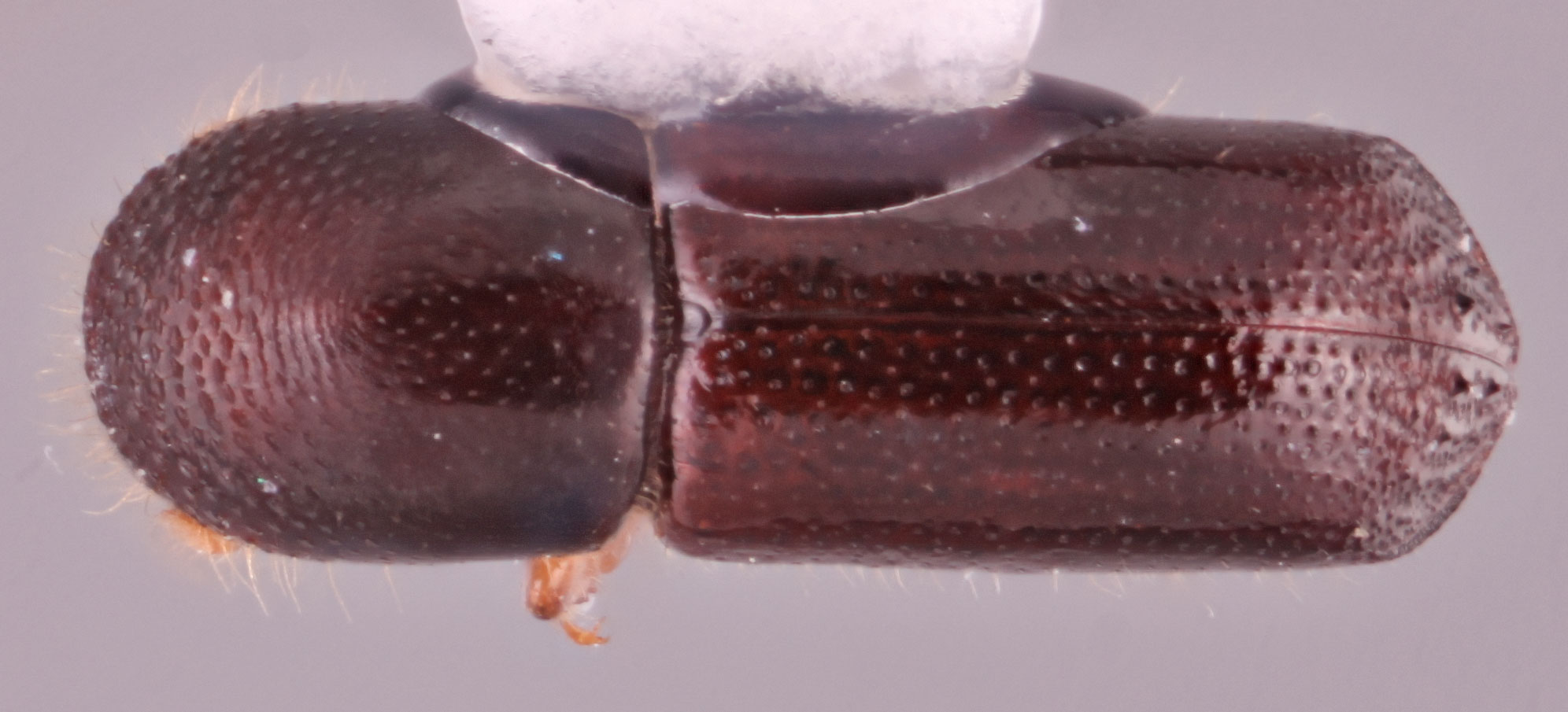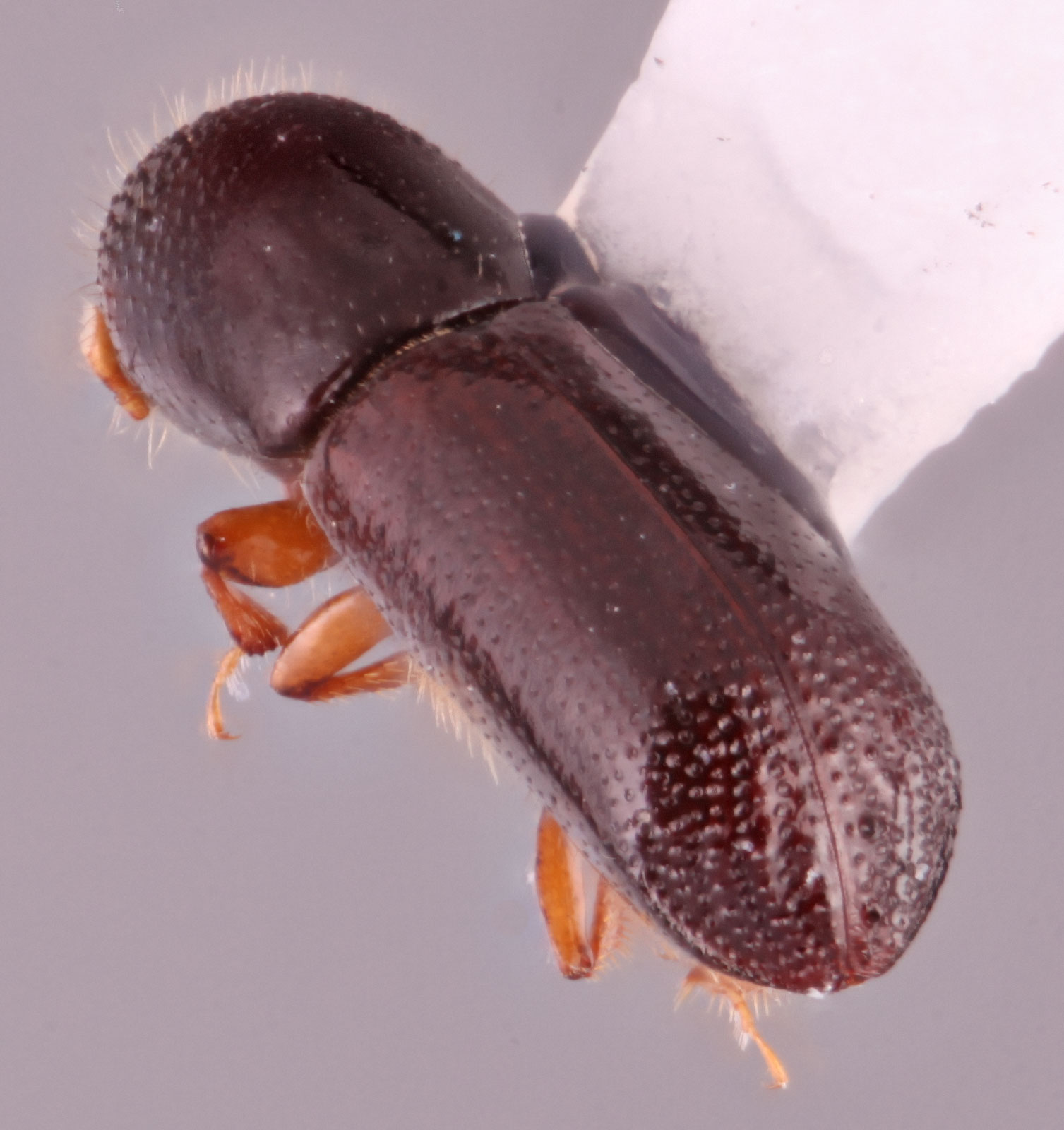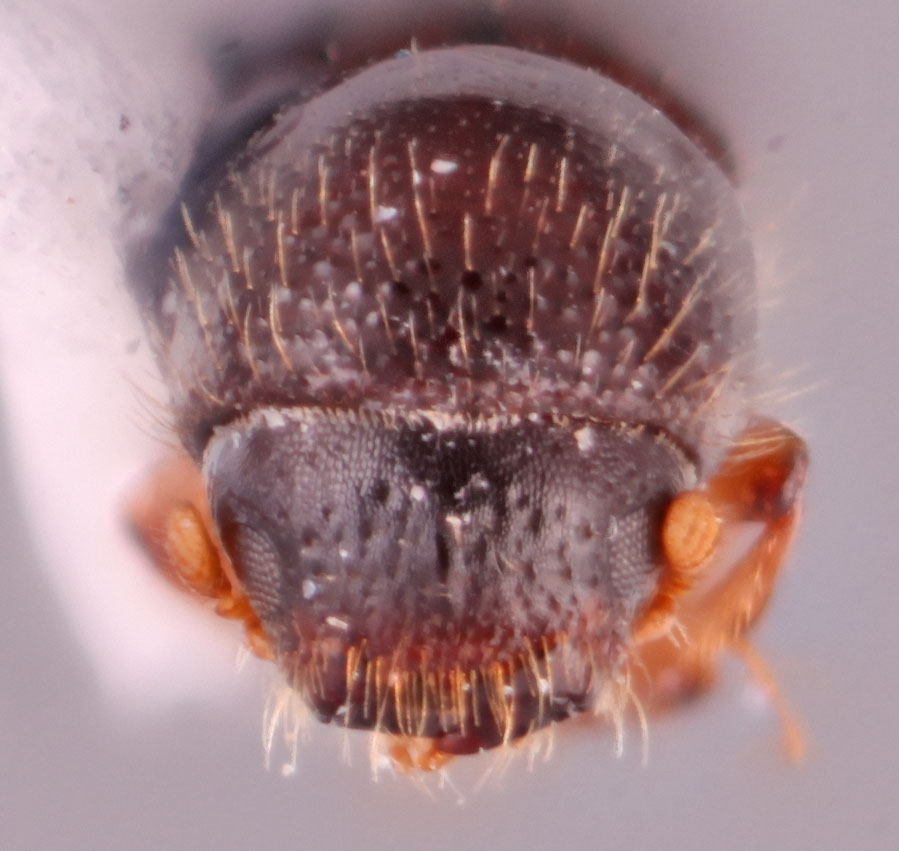Xyleborus glabratus
|
Xyleborus glabratus lateral; S.M. Smith |
|
Xyleborus glabratus dorsal; S.M. Smith |
|
Xyleborus glabratus declivity; S.M. Smith |
|
Xyleborus glabratus frontal; S.M. Smith |
Taxonomic history
Xyleborus glabratus Eichhoff, 1877: 127.
Synonyms
Xyleborus kumamotoensis Murayama, 1934: 288. Cognato et al. 2019: 1276.
Diagnosis
2.2−2.5 mm long (mean = 2.36 mm; n = 5); 3.14−3.57 times as long as wide. This species is distinguished by declivitaldeclivital:
pertaining to the elytral declivity
interstriae 1 laterally broadened from basebase:
point or edge closest to the body; opposite of apex to declivitaldeclivital:
to declivitaldeclivital:
pertaining to the elytral declivity
midpoint and then narrowing towards apexapex:
point or edge furthest from the body; opposite of base
 ; anterioranterior:
; anterioranterior:
the front or forward; opposite of posterior half of the pronotumpronotum:
half of the pronotumpronotum:
'the dorsal surface of the thorax
strongly shiningshining:
appearing glossy or bright in luster; referring to a surface that is polished and reflects light well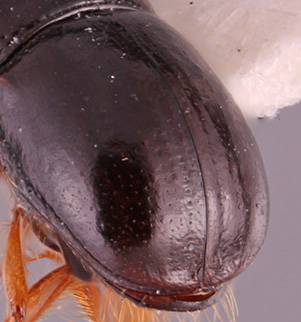 ; discaldiscal:
; discaldiscal:
pertaining to the disc of either the pronotum or elytra
interstriae two times the width of striae; discaldiscal:
pertaining to the disc of either the pronotum or elytra
strial punctures four to five times the diameter of those of interstriae; declivitaldeclivital:
pertaining to the elytral declivity
striae and interstriaeinterstria:
'longitudinal spaces along the elytra between the striae, which is not as<br />
impressed and bear smaller punctures.
 clearly distinguishable; declivitaldeclivital:
clearly distinguishable; declivitaldeclivital:
pertaining to the elytral declivity
striae flat to feebly impressedimpressed:
'a depression in a surface
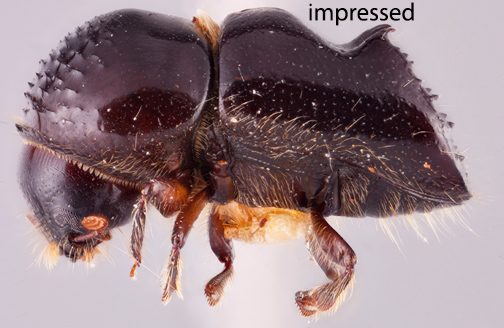 ; declivitaldeclivital:
; declivitaldeclivital:
pertaining to the elytral declivity
interstriae 1 with at least one large denticledenticle:
a small tooth, the sides of which are equal and the tip is above the middle of the base (typically three), numerous closely spaced granulesgranule:
(typically three), numerous closely spaced granulesgranule:
'a small rounded protuberance, like grains of sand
 and 1−3 small denticlesdenticle:
and 1−3 small denticlesdenticle:
a small tooth, the sides of which are equal and the tip is above the middle of the base (typically one); and posterolateralposterolateral:
(typically one); and posterolateralposterolateral:
'relating to end of the side part/portion
 margin of declivitydeclivity:
margin of declivitydeclivity:
downward slope of either the pronotum or elytra
 carinate to interstriaeinterstria:
carinate to interstriaeinterstria:
'longitudinal spaces along the elytra between the striae, which is not as<br />
impressed and bear smaller punctures.
 7.
7.
May be confused with
Xyleborus aqulilus, X. insidiosus, X. monographus, X. mysticulus
Distribution
Bangladesh, China (Fujian, Guangdong, Guangxi, Hong Kong, Hunan, Jiangxi, Sichuan, Yunnan), India (Assam, West Bengal), Japan, Myanmar, South Korea, Taiwan, Thailand, Vietnam; imported to and established in USA (Rabaglia et al. 2006Rabaglia et al. 2006:
Rabaglia RJ, Dole SA, Cognato AI. 2006. Review of America Xyleborina (Coleoptera: Curculionidae: Scolytinae) occurring north of Mexico, with an illustrated key. Annals of the Entomological Society of America 99: 1034-1056. https://doi.org/10.1603/0013- 8746(2006)99[1034:ROAXCC]2.0.CO;2, Gomez et al. 2018aGomez et al. 2018a:
Gomez DF, Rabaglia RJ, Fairbanks KEO, Hulcr J. 2018a. North American Xyleborini north of Mexico: a review and key to genera and species (Coleoptera, Curculionidae, Scolytinae). ZooKeys 768: 19-68. https://doi.org/10.3897/zookeys.768.24697)
Host plants
The species has an evident preference for the family Lauraceae, and its attacks are restricted to that family in the U.S. (Rabaglia et al. 2006Rabaglia et al. 2006:
Rabaglia RJ, Dole SA, Cognato AI. 2006. Review of America Xyleborina (Coleoptera: Curculionidae: Scolytinae) occurring north of Mexico, with an illustrated key. Annals of the Entomological Society of America 99: 1034-1056. https://doi.org/10.1603/0013- 8746(2006)99[1034:ROAXCC]2.0.CO;2, Fraedrich et al. 2008Fraedrich et al. 2008:
Fraedrich SW, Harrington TC, Rabaglia RJ, Ulyshen MD, Mayfield III, AE, Hanula JL, Eickwort JM, Miller DR. 2008. A fungal symbiont of the redbay ambrosia beetle causes a lethal wilt in redbay and other Lauraceae in the Southeastern United States. Plant Disease 92: 215-224. https://doi.org/10.1094/PDIS-92-2-0215). In the Oriental region, it has also been recorded on a few occasions from other families (Dipterocarpaceae, Fabaceae, Fagaceae, Pinaceae, Theaceae) (Beaver and Liu 2010Beaver and Liu 2010:
Beaver RA, Liu L-Y. 2010. An annotated synopsis of Taiwanese bark and ambrosia beetles, with new synonymy, new combinations and new records (Coleoptera: Curculionidae: Scolytinae). Zootaxa 2602: 1-47. https://doi.org/10.11646/zootaxa.2602.1.1, Hulcr and Lou 2013Hulcr and Lou 2013:
Hulcr J, Lou Q-Z. 2013. The redbay ambrosia beetle (Coleoptera: Curculionidae) prefers Lauraceae in its native range: records form the Chinese National Insect Collection. Florida Entomologist 96: 1595-1597. https://doi.org/10.1653/024.096.0444), but it is not clear whether it was breeding in these trees.
Remarks
Although not of economic importance in its native range, the species is an invasive pest in the U.S., where it transmits a pathogenic fungus (Raffaelea lauricola) to a variety of Lauraceae trees (including avocado) (Harrington et al. 2011Harrington et al. 2011:
Harrington TC, Yun HY, Lu SS, Goto H, Aghayeva DN, Fraedrich SW. 2011. Isolations from the redbay ambrosia beetle, Xyleborus glabratus , confirm that the laurel wilt pathogen Raffaelea lauricola , originated in Asia. Mycologia 103: 1028-1036. https://doi.org/10.3852/10-417). Consequently, its host preferences, attractant volatiles, flight activity and other aspects of its biology, and possible management and control methods, have recently been studied intensively (e.g. Hanula et al. 2008Hanula et al. 2008:
Hanula JL, Mayfield III AE, Fraedrich SW, Rabaglia RJ. 2008. Biology and host associations of redbay ambrosia beetle (Coleoptera: Curculionidae: Scolytinae), exotic vector of laurel wilt killing redbay trees in southeastern United States. Journal of Economic Entomology 101: 1276-1286. https://doi.org/10.1603/0022-0493(2008)101[1276:BAHAOR]2.0.CO;2, Hulcr et al. 2011Hulcr et al. 2011:
Hulcr J, Mann R, Stelinski LL. 2011. The scent of a partner: ambrosia beetles are attracted to volatiles from their fungal symbiont. Journal of Chemical Ecology 37: 1374-1377. https://doi.org/10.1007/s10886-011-0046-x, Brar et al. 2012Brar et al. 2012:
Brar GS, Capinera JL, McLean S, Kendra PE, Ploetz RC, Pentilde;a JE. 2012. Effect of trap size, trap height, and age of lure on sampling Xyleborus glabratus (Coleoptera: Curculionidae: Scolytinae) and its flight periodicity and seasonality. Florida Entomologist 95: 1003-1011. https://doi.org/10.1653/024.095.0428, 2013, Kendra et al. 2012Kendra et al. 2012:
Kendra PE, Montgomery WS, Niogret J, Deyrup MA, Guillen L, Epsky ND. 2012. Xyleborus glabratus , X. affinis , and X. ferrugineus (Coleoptera: Curculionidae: Scolytinae): Electroantennogram responses to host-based attractants and temporal patterns in host-seeking flight. Environmental Entomology 41: 1597-1605. https://doi.org/10.1603/EN12164, 2015, 2016, Formby et al. 2013Formby et al. 2013:
Formby JP, Krishnan N, Riggins JJ. 2013. Supercooling in the redbaby ambrosia beetle (Coleoptera: Curculionidae). The Florida Entomologist 96: 1530-1540. http://dx.doi.org/10.1653/024.096.0435, Maner et al. 2013Maner et al. 2013:
Maner ML, Hanula JL, Braman SK. 2013. Gallery productivity, emergence, and flight activity of the redbay ambrosia beetle (Coleoptera: Curculionidae: Scolytinae). Environmental Entomology 42: 642-647. https://doi.org/10.1603/EN13014, Mayfield et al. 2013Mayfield et al. 2013:
Mayfield III AE, MacKenzie M, Cannon P, Oak S, Horn S, Hwang J, Kendra PE. 2013. Suitability of California bay laurel and other species as hosts for the non-native redbay ambrosia beetle and granulate ambrosia beetle. Agricultural and Forest Entomology 15: 227-235. https://doi.org/10.1111/afe.12009, Peña et al. 2015Peña et al. 2015:
Peña JE, Weihman SW, McLean S, Cave RD, Carillo D, Duncan RE, Evans G, Krauth S, Thomas MC, Lu SS, Kendra PE, Roda AL. 2015. Predators and parasitoids associated with Scolytinae in Persea species (Laurales: Lauraceae) and other Lauraceae in Florida and Taiwan. Florida Entomologist 98: 903–910. https://doi.org/10.1653/024.098.0314). Recent field collections in its native range revealed that the beetle exhibits the same biology in its native range as it does in the U.S. (Hulcr et al. 2017Hulcr et al. 2017:
Hulcr J, Black A, Prior K, Chen C-Y, Li H-F. 2017. Studies of ambrosia beetles in their native range help predict invasion impact. Florida Entomologist 100: 257-261. https://doi.org/10.1653/024.100.0219; Cognato et al. 2019Cognato et al. 2019:
Cognato AI, Smith SM, Li Y, Pham T-H, Hulcr J. 2019. Genetic variability among native Xyleborus glabratus Eichhoff populations and the description of two related species. Journal of Economic Entomology 112: 1274-1284. https://doi.org/10.1093/jee/toz026).
DNA data
Sequences available for COI and CAD.
COI: MK251515; MK251518; MK251519; MK251520; MK251521; MK251514; MK251506; MK251517;
MK251509; MK251505; MK251512; MK251522; MK251513; HM064127; OP617779
CAD: MK251533; MK251536; MK251537; MK251538; MK251539; MK251532; MK251524; MK251535;
MK251527; MK251523; MK251530; MK251540; MK251531; HM064306; OP607208


